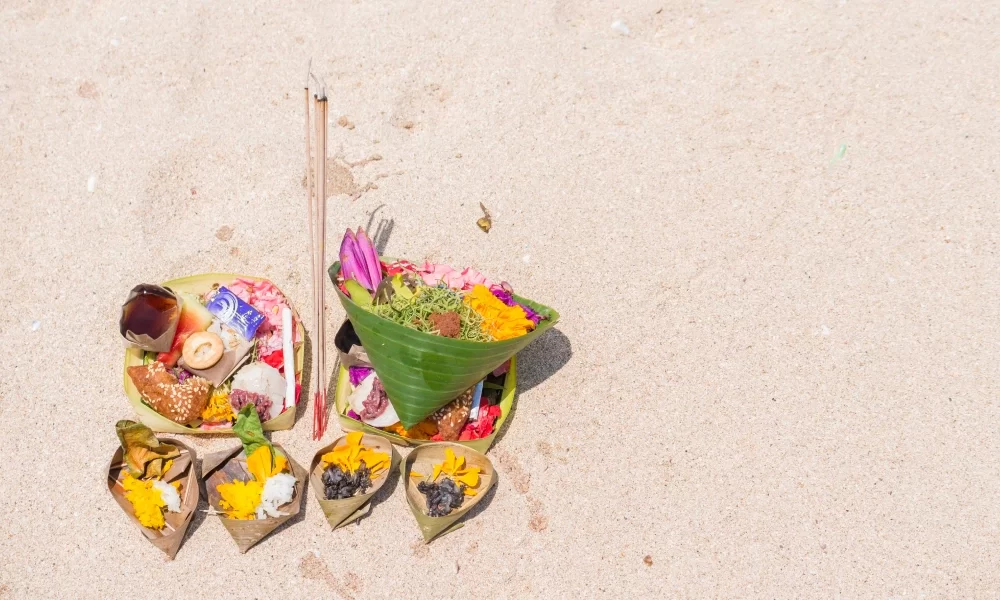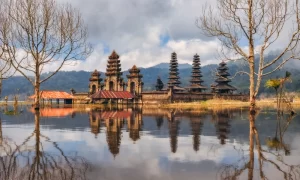Despite the likelihood that you have visited Bali Island frequently, do you know what the word “Bali” actually means?
The word Bali itself means “offering,” and this is reflected in the Balinese people’s culture in their day-to-day activities.
The so-called offering ceremony permeates every part of Balinese culture. From lavish sacrifices made during important occasions to modest sacrifices known as canang sari.
We shall examine canang sari in more detail in this article, including its philosophy and purpose.
What is Canang Sari?
In etymology, the word Canang derived from the old language used in Bali and Java called Kawi language. “Ca” means beautiful, and “Nang” means purpose. While “sari” itself means essence.
As explained in “Kamus Bahasa Bali’, the word Canang could be translated as betel. Betel has a very high position in the cultures of Bali and Java in the past as one of the valuable offerings to honourable guests who come to the house.
Canang sari itself is made from a small palm leaf tray with some elements above it, like rice, flowers, incense, fruits, spices and sometimes cigarettes or coffee.
You can see these small offerings in Balinese temples, houses, shops, cars and streets on a daily basis.
The Purpose & Philosophy of Canang Sari

Although it would appear to be a random arrangement of vibrant flower petals, it has a distinct meaning, serves a purpose, and pays homage to a particular Hindu deity.
The following are some of the components found in the canang sari:
1. Ceper
Ceper is the base of a canang (offering) that has a square shape and symbolizes the angga-sarira (body).
The four sides of the ceper symbolize the components of the angga-sarira, which are the Panca Maha Bhuta (five universal elements), Panca Buddhindriya (five senses), Panca Tan Matra (five objects that can be captured by the senses), and Panca Karmendriya (karmic act of senses).
The canang that is covered with ceper is a symbol of Ardha Candra, while the one covered with small tamas is a symbol of Windhu.
2. Rice
Rice or wija symbolises Sang Hyang Ātma or that which makes the body alive, symbolising the seed at the beginning of life that comes from Ida Sang Hyang Widhi Wasa in the form of Ātma.
3. Porosan
Porosan or peporosan is made from betel leaves, lime, and gambir (a type of plant resin) which symbolise the Tri-Premana, which are Bayu (“thought”), Sabda (“speech”), and Idep (“action”).
These three make the living body able to perform activities. Porosan also symbolises the Trimurti, which are Siwa (lime), Wisnu (betel), and Brahma (gambir).
Porosan has the meaning that every person should have a heart (poros) full of love and compassion as well as deep gratitude to Ida Sang Hyang Widhi Wasa.
4. Snacks, sugarcane, and banana
Snacks, sugarcane, and bananas are symbols of Tedong Ongkara which symbolise the strength of Upetti (creator), Stiti (preserver), and Pralinan (destroyer) in life in the universe.
5. Sampian uras
Sampian uras or also called duras is made from a series of palm fronds arranged in a circular shape, usually consisting of eight segments or blades which symbolise the wheel of life with its asta iswarya (“eight characteristic”) that accompany every human life.
6. Flowers
Flowers placed on top of the sampian urasari symbolise peace and sincerity of heart. The arrangement of flowers is as follows:
- White flowers are arranged in the east as a symbol of the strength of Sang Hyang Iswara.
- Red flowers are arranged in the south as a symbol of the strength of Sang Hyang Brahma.
- Yellow flowers are arranged in the west as a symbol of the strength of Sang Hyang Mahadewa.
- Blue or green flowers are arranged in the north as a symbol of the strength of Sang Hyang Wisnu.
- Kembang rampai is arranged in the middle as a symbol of the strength of Sang Hyang Panca Dewata.
7. Kembang Rampai
Kembang rampai is placed on top of the arrangement of flowers and has the meaning as a symbol of wisdom.
There are various flowers, some fragrant and some not, symbolising that human life is not always happy or difficult.
Therefore, in organising life, one should have wisdom.
8. Lepa
Lepa or boreh miyik is a symbol of good behaviour and conduct.
Behaviour determines the evaluation of society on the goodness or badness of someone.
Lepa is also a symbol of devotion and surrender to Ida Sang Hyang Widhi Wasa.
9. Fragrant Oil
Fragrant oil or miyik-miyikan is a symbol of inner peace or self-control. In organising life, one should conduct it with good inner peace and self-control.
A canang sari is more difficult to make than it first appears. Women are typically in charge of creating the Balinese offerings, or canang, in Balinese Hinduism.
A decent Balinese wife is expected to be able to make a canang sari because it is one of their everyday tasks. Canang creation is a metanding ritual.
They often sit down together to put canang sari together; they manufacture between 50 and 70 pieces of canang and use between 15 and 17 of them for daily offerings.
The pre-made canang sari is now offered on the market as more Balinese women work outside of their regular duties.

